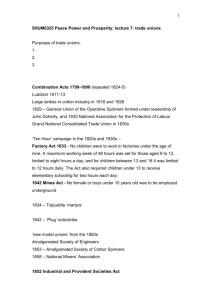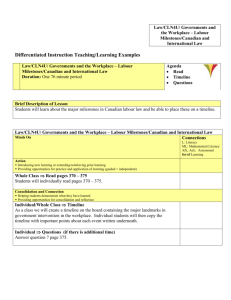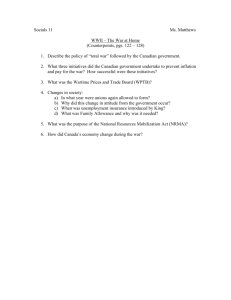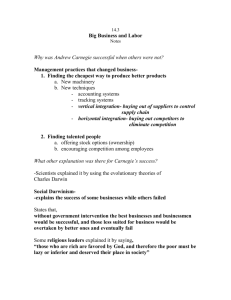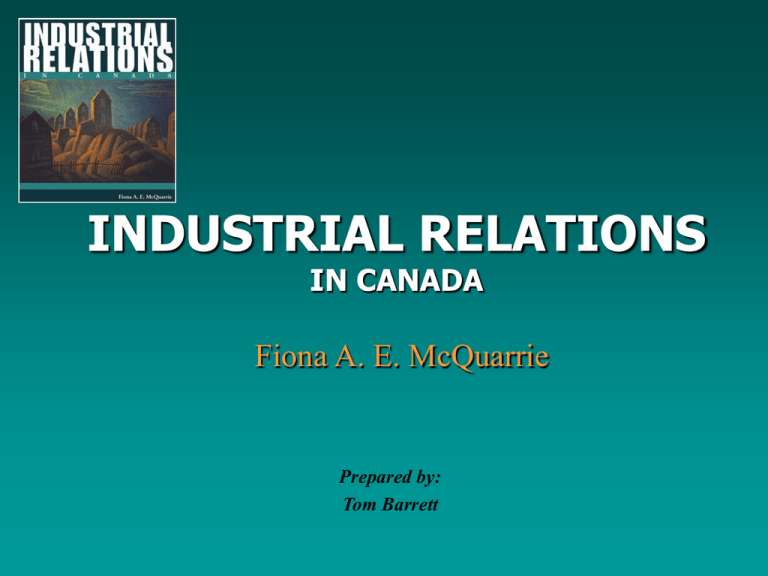
INDUSTRIAL RELATIONS
IN CANADA
Fiona A. E. McQuarrie
Prepared by:
Tom Barrett
Chapter
3
History of the Canadian Union
Movement
Opening Vignette:
The Miners’ Meeting
• United Mine Workers of America strike,
Vancouver Island, 1913
• The local militia leader, Colonel Hall,
surrounded the hall where miners were
meeting and placed machine guns at the back
door
• Following a report that there were weapons
in the hall, the Colonel gave the miners two
minutes to clear out; he later extended this to
one hour
Opening Vignette:
The Miners’ Meeting
• At the end of the meeting, after they had
voted to accept the company’s offer, the
miners were marched out of the hall, guarded
by soldiers with fixed bayonets
• Forty-three miners were detained; the rest
were kept under guard until 2 a.m. No
ammunition was found
Chapter 3 Objectives
• At the end of this chapter, you should be able to:
– Describe the geographic, cultural, economic, and
political factors that are relevant to Canada
– Identify the major events in Canadian labour
history
– Understand the role of craft and industrial
unionism in shaping Canadian union structure
– Discuss how American unions have influenced
Canadian unions
– Identify some of the regional differences in
Canadian labour history
History of Canadian Labour
Movement
• Union history in Canada has been marked by
conflict between different cultures, classes,
and regions
• Several distinct characteristics of Canada
have helped shape its labour history
History of Canadian Labour
Movement
• Canadian characteristics that have shaped labour
history:
– Physical geography
• Canada's large size meant most early unions were local or
regional
• Resource-based industries hampered union organizing
• Proximity to U.S. influenced Canadian unions
– Cultural mix
• Immigrants with organizing experience helped develop
Canadian unions
• However, unions have not always responded well to
culturally diverse workforces
History of Canadian Labour
Movement
– Economic system
• Historically based in primary and secondary industries,
but toward the end of the 20th century, role of tertiary
(or service) industries had grown
• Reliance on trade has challenged unions
– Political structure
• Division between federal and provincial jurisdictions
has allowed for experimentation and reform
Early Canadian Unionism:
the 1800s
• The period of local unionism
– Earliest attempts to organize were limited to
specific geographic areas and small groups of
workers—usually in one trade; known as the
craft union model
– Two main reasons:
• Size of Canada
• The need to protect wage rates for workers in
skilled trades
– Canada's role as exporter also contributed
Early Canadian Unionism:
the 1800s
• Informal workers' groups formed as early as 1827
• First formal unions emerged around the same time;
historians differ on which one was the first Canadian
union
• Prevalence of craft unionism initially inhibited any
wider union growth; did not encourage alternative
model, known as industrial unionism
• Industrial unionism
– Focuses on “strength in numbers”
• Maximizing power by recruiting as many members as
possible, regardless of their occupation
Early Canadian Unionism:
the 1800s
• Due to the dominance of craft unions, the next major
expansion of the Canadian labour movement came
through affiliation with international unions, usually
based in the U.S.
• Mid- and late-1800s saw the continental movement
of U.S.-based unions entering Canada
• Restricted primarily to Ontario and other regions with
trade links to the U.S.
• Late 1800s:
– unions began to cooperate, e.g., the Nine-Hour
Movement (1872); employers resisted the movement,
resulting in Toronto typesetters' and printers' strike
Early Canadian Unionism:
the 1800s
• The Nine-Hour Movement and the Toronto
typesetters' and printers' strike
• At the time, there was almost no Canadian
legislation addressing industrial relations issues
• The British government had used “criminal
conspiracy” or monopoly laws to block union
organizing until 1871, when it passed the Trades
Union Act, establishing the right of workers to
organize a union
Early Canadian Unionism:
the 1800s
• Similar monopoly laws were used in Canada
to arrest and charge 24 leaders of the
Toronto strike; charges laid by George Brown,
publisher of the Globe newspaper and an
enemy of Prime Minister Sir John A.
Macdonald
• Macdonald adopted a Canadian version of
Trades Union Act to punish Brown; while the
charges were dropped, the Nine-Hour
Movement was broken
Early Canadian Unionism:
the 1800s
• The Nine-Hour Movement led to the
formation of the first federations of trade
unions, the Canadian Labour Union (1873)
and the Trades and Labour Congress (TLC)
– The TLC:
• Was formed in 1883
• Lobbied for reforms to labour legislation that
would benefit all workers
• Remained a national force in the Canadian
labour movement for the next 70 years
Early Canadian Unionism:
the 1800s
• The Knights of Labor
– First international industrial union to enter
Canada (1881)
– Organized workers in occupations that
Canadian unions considered too challenging,
such as railway work, mining and other
resource industries
– Organized women and minority workers
– Denounced by a papal letter in Quebec; the
letter was rescinded in 1887
The Industrial Age: the Early
1900s
• Work in Canada continued to evolve from rural-based,
individually controlled work to urban, factory-based
• U.S. ownership of Canadian industries exacerbated the
effects of separation between capital and labour
• U.S. union organizers came to Canada to recruit
members
• Federal Conciliation Act (1900) created federal
department of labour; gave it power to appoint thirdparty intervenors or commissions of inquiry
• 1902 - The TLC elects a craft union member for
president; expels Knights of Labor and national unions
The Industrial Age: the Early
1900s
• An active economy created high demand for workers,
allowing them to press for better wages and working
conditions
• Railways were expanding rapidly and became a
target for organizers, leading to several major railway
strikes
• American unions representing railway workers in
some cases sided with owners—an indication that the
continental movement might have negative
implications for Canadian workers
The Industrial Age: the Early
1900s
• Railway strikes led to passage of Industrial
Disputes Investigation Act (1907); the act:
– Required that industrial disputes under federal
jurisdiction be submitted to a neutral third
party
– Introduced principles that are still present in
many current Canadian labour laws
The Industrial Age: the Early
1900s
• In Atlantic Canada, unions had been more
active in organizing less-skilled and non-craft
workers than in central Canada
• Atlantic Canada saw 411 strikes between
1901 and 1914, most of them by coal miners,
represented by the Provincial Workmen's
Association
• 140 of those strikes were by associations of
unskilled labourers
The Industrial Age: the Early
1900s
• Economic growth lasted until about 1914, when
U.S.-based unions made up about 80 percent of
total Canadian union membership
• U.S. domination was partly due to the Industrial
Workers of the World (IWW), the “Wobblies”
• IWW was similar to Knights of Labor in
philosophy and strategy, but had a more socialist
orientation, advocating general strikes as a
means of creating a new, egalitarian society
The First World War
• The advent of the war made unionization
more attractive to Canadian workers
– Increased production that was needed to
supply the war effort put pressure on workers
to produce more for the same pay
– Continuing mechanization of production
further reduced the market value of skilled
craftspeople
The First World War
• The First World War
– The federal government expanded the
jurisdiction of the Industrial Disputes
Investigation Act to include munitions
industries, which limited the ability of workers
in those industries to strike
• Many workers felt existing unions were not
adequately addressing workers' concerns,
e.g., by not formally opposing conscription.
This drove some to more radical unions, such
as the U.S.-based One Big Union (OBU)
The First World War
• Two events demonstrate the extreme
divisions between workers, government and
employers:
– Albert “Ginger” Goodwin, B.C. labour
organizer, was shot and killed by a Dominion
Police officer; his death led to a one-day
general strike in Vancouver
– The Winnipeg General Strike (1919) was the
first extended, large-scale general strike
involving workers from many different
occupations and unions
The First World War
• The Winnipeg General Strike
– This strike began when 30,000-35,000 unionized and
non-unionized workers walked off their jobs
– A committee representing employers and all three levels
of government attempted to force strikers back to work
– Winnipeg mayor fired the entire city police force; police
were replaced with volunteer “special constables”
– Parliament passed emergency amendment to the
Immigration Act allowing for immediate deportation of
immigrants; also broadened the Criminal Code allowing
police to arrest on basis of suspicion, rather than
evidence; burden of proof was placed on the accused
The First World War
– Eight strike leaders were arrested and charged
– Royal Northwest Mounted Police broke up strikers’
protest march on June 21; two people were killed
and 30 seriously injured
– Strike ended June 25; strike leaders realized their
objectives couldn’t be accomplished due to
opposition from government, business, and
employers
– However, it was a turning point in the Canadian
labour movement
– OBU began to wane as infighting rose and many
members found themselves unable to pay dues
The First World War Era
• In Quebec, at the end of the decade,
unions gained strength because of
the influence of the
Catholic Church
• In 1921, so-called Catholic
unions formed the Confédération
des travailleurs catholiques du Canada
(CTCC); the CTCC became increasingly
militant toward the “practised ethnocentrism”
of American-owned firms
The First World War Era
• The CTCC was involved in several high-profile
strikes, including the 1949 Asbestos strike,
which was seen as a victory against U.S.
firms and the Duplessis government
• In 1961, it became the Confédération des
syndicats nationaux (CSN) or, in English, the
Confederation of National Trade Unions
(CNTU), which exists today
After the War
• Canadian unions faced many difficulties after the First
World War, including:
– Widespread unemployment and wage cuts
– Disunity within the movement
– A poor agricultural market, the U.S. stock market crash
(1929), and the subsequent Great Depression
• In contrast, some positive developments occurred:
– Skilled workers were still needed and were able to maintain
unity
– “Industrial councils” were formed and included less-skilled
workers
– Communities of ethnic immigrants within occupations
created networks for support and information
After the War
• During the Depression, unemployed workers
banded together to lobby for improved “relief
payments”; also demanded better conditions
in government-run “relief camps”
• Two major events demonstrated the extent of
resistance to the relief camps
– The “On to Ottawa Trek” (1935), which ended
in a violent clash with RCMP in Regina
– “Bloody Sunday,” the Vancouver post office
riots (1938)
After the War
• The Canadian Communist Party became an
attractive political alternative for some
disillusioned workers; the party promoted
unionism as a way to transform capitalism
• In 1927, the Communist Party launched the
All-Canadian Congress of Labour, the first
major alternative to the TLC as a national
federation for Canadian unions
After the War
• Snider vs. Toronto Electrical Commission
– This 1925 ruling by the British Privy Council
settled the question of federal and provincial
jurisdiction over labour relations
– Federal government’s jurisdiction over labour
relations extended only to federally regulated
industries
– Ruling hampered development of Canadian
unions because organizing was more difficult
under varying laws
After the War
• The Wagner Act (1935)
– U.S. legislation introduced by President Franklin
Roosevelt guaranteed three basic rights to U.S. union
members
• The right to organize
• The right to collective bargaining
• The right to strike without employer harassment
– Employers were forced to recognize a union that had
the support of the majority of workers
– Several provinces adopted similar legislation
– This act was the model on which many Canadian
labour codes were based and contains principles that
are still present in Canadian labour laws
After the War
• The Congress of Industrial Organizations (CIO)
– Founded in the U.S. in 1935 to represent workers in massproduction industries and to organize unorganized workers
– Clashed with the American Federation of Labor (AFL)
– AFL instructed the TLC to expel Canadian unions linked to
CIO affiliates, which it did reluctantly
– The CIO opened a Canadian office in 1937 and organized
steelworkers, autoworkers, and other production workers
• Also during the Depression, the Co-operative
Commonwealth Federation (CCF)—a forerunner of the
New Democratic Party, elected its first members of
Parliament
The Second World War
• Stimulated the economy, dramatically increasing
employment
• Fearing radicals and militants would disrupt production,
the federal government expanded the jurisdiction of the
Industrial Disputes Investigation Act in 1939 and
required strike votes
• The government also introduced wage and price controls
• Unionization rates increased significantly with the war,
and the divisions between craft and industrial unions
became more formal at the national levels of the union
movement
The Second World War
• The All-Canadian Congress of Labour and the CIO
joined to form the Canadian Congress of Labour
(CCL), giving Canada two national labour federations:
– The CCL - industrial-union based; affiliated with the
CIO in the U.S.
– The TLC - craft-union based; affiliated with the AFL
• Strike activity increased during the first few years of
the war and by 1943, one in three union members
was on strike
• Following a long and bitter strike by northern Ontario
gold miners in 1941-42, the federal government
amended its labour legislation
The Second World War
• In 1944, the federal government passed P.C. 1003,
modelled on the Wagner Act
• P.C. 1003 included compulsory collective bargaining
and the right of “employee representatives” to be
certified as bargaining agents if they could
demonstrate sufficient support
• Similar acts were passed by Quebec and B.C.
After the Second World War
• The war was followed by fears that the post-First
World War recession would be repeated; Mackenzie
King’s government tried to offset this by giving
benefits to returning veterans
• The first major post-war strike occurred in 1945, at
the Windsor, Ont. Ford plant
• Justice Ivan Rand decided union dues would be
automatically deducted from every worker’s
paycheque, but that individuals would be allowed to
opt out of the union
• The Rand Formula was being used by 90 percent of
Canadian unions by 1950
After the Second World War
• Post-war price increases led unionized workers to
demand matching wage increases
• Many employers, assuming P.C. 1003 had been a
temporary measure, did not respond to union
demands
• The result was a series of large, extended strikes
that began in 1946 and continued for the next
four years
• The federal government enshrined the principles
of P.C. 1003 in the Industrial Disputes
Investigation Act (1948) and by 1950, nearly
every province had a similar labour code
After the Second World War
• The Asbestos Strike (1949)
– An illegal strike, supported by Catholic churches and the
Archbishop of Montreal
– Quebec Premier Duplessis sent armed police to Asbestos;
strikers responded by beating company officials and
dynamiting company property
– May: Strikers, incensed that the company had hired
replacement workers, attacked the mines and the police;
over 200 were arrested
– June: A settlement was negotiated
– Served notice to the world that the Catholic unions were no
less militant than their secular counterparts
– Marked the end of the formal relationship between the
Catholic Church and the Quebec union movement
The 1950s and 1960s
• Period of growth and development for unions
• Inter-union disputes were reduced when the TLC and CCL
merged in 1956 to create the Canadian Labour Congress
(CLC); the CLC affiliated with the Quebec Federation of
Labour (QFL)
• Concerns during this period included increasing
bureaucratization and centralization of the predominantly
international unions
• Bitter disputes:
– Murdochville, Quebec (1957): violent mining strike ended with
the union conceding defeat
– Newfoundland (1958-59): International Woodworkers of
America (IWA) clashed with Premier Smallwood; policeman
killed during fighting and the IWA was defeated
The 1950s and 1960s
• Early 1960s saw the beginning of an extended
growth period in the labour movement, due
mostly to extensive organizing in the public sector
• Private-sector wages and conditions were
becoming superior to public sector
• 1965 - public sector unionization became a priority
for the federal government, due to a national
postal strike and the election of a Liberal minority
government that was dependent on the New
Democratic Party for support
The 1950s and 1960s
• Ottawa passed the Public Service Staff
Relations Act, which gave federal public
servants the right to arbitration or strike
action
• This act served as a model for most provinces
and by 1975 every province and territory had
some form of labour relations legislation
governing public service employees
The 1950s and 1960s
• During the same period, para-public sector
workers also organized on a large scale
• Some joined existing public-sector unions;
others joined the Canadian Union of Public
Employees (CUPE), a newer union that
organized municipal and regional government
workers
• Also during this period, changing technology
affected workplaces, including railways and
newspapers
The 1970s and 1980s
• The early 1970s saw disruption in the
Canadian economy
– Unemployment and inflation rose
– North America was challenged by new
economic powers in other parts of the world
• Unions were blamed for inflation and lower
productivity
The 1970s and 1980s
• In October 1975, the federal government
implemented a three-year program of wage
and price controls; collective agreements had
to be approved by the Anti-Inflation Board
• Strike activity rose significantly after controls
were imposed; over one million workers took
part in a one-day national strike on October
15, 1976
• When the program ended in 1978, its effects
were unclear
The 1970s and 1980s
• Early 1980s
– Interest rates were increased to fight inflation,
causing the worst unemployment since the
1930s
– Social programs were restricted
• Federal and provincial governments reduced
the bargaining power of public sector unions
The 1970s and 1980s
• The 70s and 80s saw numerous high-profile
strikes in the public and private sector
– 1972 Quebec public sector strike
– 1978 national postal strike
– 1978 eight-and-a-half-month-long
strike by Ontario steelworkers,
followed by another lengthy strike in 1981
• In 1982, the federal government suspended
public servants’ bargaining rights for two
years
The 1970s and 1980s
• The federal Charter of Rights and Freedoms
(1982) provided new guidelines for labour
relations
• The election of a federal Conservative
government in 1984 and the emergence of
major business alliances such as the Business
Council on National Issues, created a hostile
atmosphere for unions
• Several major private-sector strikes during
the 1980s
The 1970s and 1980s
• Labour movement also saw internal dissent:
– The Confederation of Canadian Unions (CCU),
intended as a national federation for
Canadian-based unions, presented an
alternative to the CLC
– Construction unions broke away from the CLC
to form the Canadian Federation of Labour
(1982-1997)
– Canadian locals of the United Auto Workers
split from U.S. parent union to form the
Canadian Auto Workers
The 1970s and 1980s
• The trend that developed toward Canadian
control of Canadian unions has continued to
the present day
• The demise of the CFL and the CCU has left
the CLC and the QFL and CNTU as the major
labour federations in Canada
The 1990s and Beyond
• The advent of liberalized international trade
was the major event of the 1990s
• This includes the North American Free Trade
Agreement (NAFTA) of 1992 and Canada’s
participation in worldwide tariff reductions
under the 1994 General Agreement on Tariffs
and Trade and the World Trade Organization
The 1990s and Beyond
• Some employers have used NAFTA to move
formerly unionized jobs to regions with lower
labour costs and non-unionized workers
• Unionization rates in Canada did not drop
significantly in the 1990s, although there has
been a slow gradual decline since the 1970s
• The New Democratic Party, historically
labour’s best friend in politics, declined during
the 1990s; it remains to be seen what effect
this will have on labour policy
The 1990s and Beyond
• The future can be viewed negatively or
positively for unions
– Negative perspective
• Internationalization, the slow decline in
unionization rates, and the decline of the NDP,
could suggest further erosion of unions’ power
– Positive perspective
• The relative strength of Canadian unions
compared to those in the U.S. and the history
of adaptability of the Canadian system suggest
that the system will continue
Copyright
Copyright © 2002 John Wiley & Sons Canada, Ltd. All rights reserved.
Reproduction or translation of this work beyond that permitted by
CANCOPY (Canadian Reprography Collective) is unlawful. Request for
further information should be addressed to the Permissions Department,
John Wiley & Sons Canada, Ltd. The purchaser may make back-up copies for
his / her own use only and not for distribution or resale. The author and the
publisher assume no responsibility for errors, omissions, or damages, caused
by the use of these programs or from the use of the information contained
herein.

